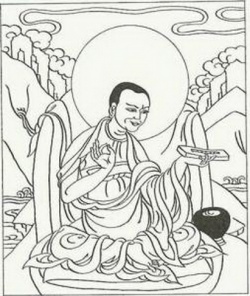Mahakashyapa
Mahākāśyapa (Sanskrit; Pali: Mahākassapa; Japanese: 摩訶迦葉 Maha Kasho or Makakasho) or Kāśyapa was from Magadha, who became one of the principal disciples of Śākyamuni Buddha and who convened and directed the first council.
In early Buddhism
Mahākāśyapa is one of the most revered of the Buddha's early disciples, foremost in ascetic practices. He is often depicted in statuary together with Ananda, each standing to one side of the Buddha.
In the Lotus Sutra
In Lotus Sutra Chapter 6 (Bestowal of Prophecy), the Buddha bestows prophecies of enlightenment on the disciples Mahakashyapa, Subhuti, Maha Katyayana, and Mahamaudgalyayana.
In Zen Buddhism
According to Zen, Mahākāśyapa was the first to receive Dharma transmission from Gautama Buddha. Zen purports to lead its adherents to insights akin to that mentioned by Śākyamuni Buddha in his Flower Sermon in which he held up a white flower and just admired it in his hand. All other disciples just looked on without knowing how to react, but Mahākāśyapa smiled faintly, and Śākyamuni Buddha picked him as one who truly understood him and the worthy one to be his successor. (This can be explained thus: Mahākāśyapa's spiritual attainment had reached the point where he can understood the hidden meanings conveyed by the Buddha's act, like two people who have undergone the same experiences understand each other completely.)
The words of the Śākyamuni Buddha addressed to Mahākāśyapa are described below:
I possess the true Dharma eye, the marvelous mind of Nirvana, the true form of the formless, the subtle dharma gate that does not rest on words or letters but is a special transmission outside of the scriptures. This I entrust to Mahākāśyapa.
Thus, a way within Buddhism developed which concentrated on direct experience rather than on rational creeds or revealed scriptures. Zen is a method of meditative religion which seeks to enlighten people in the manner that the Mahākāśyapa experienced.
In the Song of Enlightenment (證道歌 Zhèngdào gē) of Yongjia Xuanjue (665-713) —one of the chief disciples of Huìnéng, the 6th patriarch of Chan Buddhism—it is written that Bodhidharma was the 28th patriarch in a line of descent from Mahākāśyapa, a disciple of Śākyamuni Buddha, and the first patriarch of Chan Buddhism:
Mahākāśyapa was the first, leading the line of transmission;
Twenty-eight Fathers followed him in the West;
The Lamp was then brought over the sea to this country;
And Bodhidharma became the First Father here:
His mantle, as we all know, passed over six Fathers,
And by them many minds came to see the Light.
In Chinese culture
According to Chinese legend, the monk Ji Gong is a reincarnation of Mahākāśyapa (known as the Taming Dragon arhat).
